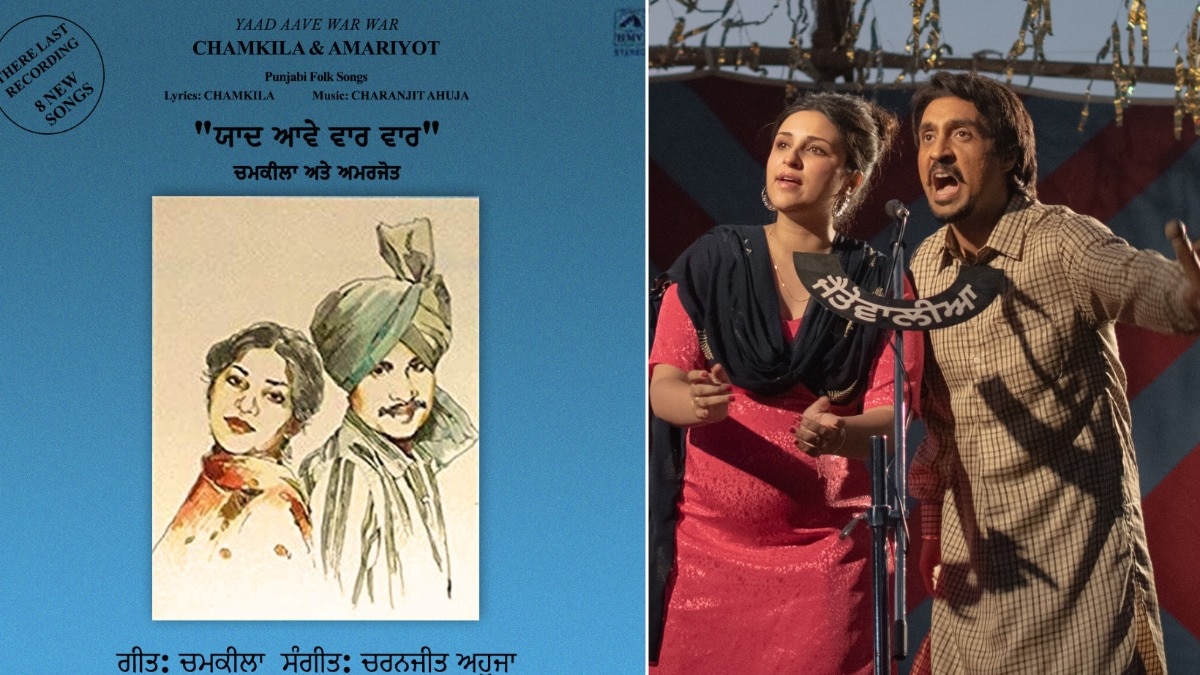Amar Singh Chamkila’s life has all the drama that a filmmaker can dream of. A poor Dalit labourer skyrocketing to success because of his mass appeal as a singer. And then his life being cut short by a hail of bullets when he was just 27.
Filmmaker Imtiaz Ali’s film on Chamkila, the best-selling Punjabi singer of his time, has shone the spotlight again on the controversial artist. However, a real-life legend is conspicuously missing from the Imtiaz Ali film Amar Singh Chamkila. The legendary music director Charanjit Ahuja, who took Chamkila to the masses and made him the star he went on to become in his short but eventful career.
If Chamkila was a ‘pendu’ whose voice had an earthy flavour, it was ace music director Charanjit Ahuja who added the finesse to Chamkila’s records.
If the story of Chamkila, a Dalit who started his life as a labourer, is one for folklore, the role played by Charanjit Ahuja, now in his 80s, in shaping him and other Punjabi music icons like Gurdas Maan, Hans Raj Hans and Sardool Sikander is phenomenal.
“The role of Charanjit Ahuja in the life of Chamkila was humongous,” Imtiaz Ali tells IndiaToday.In.
“Charanjit Ahuja added a certain musicality to Chamkila’s songs, which were at that point of time very different, modern, that kind of put Chamkila and many others with whom Charanjeet Ahuja worked with on a certain pedestal of musicality,” Imtiaz Ali tells IndiaToday.In.
THE MUSIC DIRECTOR WHO TOOK CHAMKILA TO THE MASSES
Author and film critic Bobby Sing explains that it was only because of Charanjit Ahuja that Chamkila became a phenomenon of his time.
“Chamkila reached the masses through his recorded vinyl records and cassettes. He became the most-demanded stage singer in Punjab because of those records and cassettes, which were selling even in remote areas. A majority of these albums were recorded under the music direction of Charanjit Ahuja,” Bobby Sing tells IndiaToday.In.
He says that it was Ahuja who made Chamkila and Amarjot Kaur, his wife and duet partner, a commercial success. It is also because of him that we remember Chamkila and Amarjot the way we do.
“So, the way you hear the voice of Chamkila and Amarjot Kaur in these recordings, how they sound on the mike, how their songs begin, the music preludes and interludes in the tracks and their final mastering, everything was conducted by Charanjit Ahuja as the solid pillar behind the couple’s commercial success,” says Sing.
Therefore, it is surprising that there is just a blink-and-miss appearance of the character playing Charanjit Ahuja in the Imtiaz Ali directorial Amar Singh Chamkila. It is as if a legend has been dismissed in a split-second scene.
“Chamkila is a commercial film and the focus of the biopic is to give a larger-than-life image to the singer, Chamkila. It is kind of unidimensional and Chamkila has been shown as a one-man army fighting against all odds. Indeed, the contribution of Charanjit Ahuja has been given a marginal place in Chamkila’s rise as a singer in the film,” author and academician Kumool Abbi tells IndiaToday.In.
Imtiaz Ali calls Charanjit Ahuja a “master musician”, and says it was Ahuja who was his first port of call when he started researching for the movie. Imtiaz Ali’s movie, Amar Singh Chamkila, in which Diljit Dosanj plays Chamkila the singer, has won rave reviews from experts and the public alike.
“Charanjit Ahuja sahab was the first person I met to start my research on Chamkila, and I got very valuable insight from him. I must say that Charanjit Ahuja was a guide not only for music, but for Chamkila he was a guide to how to be. Because Charanjit Ahuja was a sophisticated man, an educated man, a classy person,” Imtiaz Ali says, contrasting the earthy background of Chamkila with Ahuja’s sophistication.
“Chamkila used to respect Charanjit Ahuja so much that he didn’t use to sit when Ahuja was in the room,” adds Imtiaz Ali.
The filmmaker says he has tried to highlight the “more dramatic and unique struggles of Chamkila” and therefore given a miss to the “calmer influence” of Ahuja on the singer’s life.
WHY CHARANJIT AHUJA, AND NOT CHAMKILA, IS A LEGEND
It was Charanjit Ahuja who shaped the illustrous career of Chamkila, which was cut short by the singer’s murder when he was just 27. That murder still remains an unsolved mystery and adds to the legend of Chamkila the singer.
“Charanjit Ahuja has had a long illustrious career as a producer with HMV, the record company that had a monopoly in the country,” says Kumool Abbi, a professor of sociology at Panjab University.
“When Chamkila began, it was the time of LP records or ‘taave’ in India. If Charanjit Ahuja had not approved of Chamkila’s raw talent, music and singing, and not agreed to bring out the album with Surinder Sonia, Chamkila might have been lost in oblivion,” she adds.
After the vinyls, came the cassettes and Chamkila’s songs were carried across India by Punjabi truck drivers.
Bobby Sing says that in the past decades or so, we have actually started using the term ‘legend’ “too casually for anyone and everyone”.
Sing says Chamkila was certainly a huge star of his times, the best-selling artist for the record company, but his murder eventually made him a much bigger cult figure with passing time.
“But yes, in the process, Imtiaz misses out crediting some, who deservingly had to be there in the biopic of a singing star,” says Bobby Sing.
It was not just Chamkila, Charanjit Ahuja definitively touched dozens of Punjab’s musicians.
“Charanjit Ahuja is the real living legend of Punjabi music. He is like the banyan tree that gives energy to others to grow and is a witness to generations changing in front of him along with the change in the eras,” says Sing. “He has worked with almost all the artists active in Punjabi music in the three decades from the 1980s to 2010 and has also trained many renowned composers of present times.”
Professor Kumool Abbi says Ahuja had the expertise and capacity to discover talent and shape careers.
Singers including Surinder Shinda, Sardool Sikandar, Hans Raj Hans, Sabar Koti, Satwinder Bugga and even the legendary Gurdas Mann “were all spotted by Ahuja’s keen eyes and given legitimacy to be launched by HMV”, according to her. This, she adds, provided them with access to the music market and a bigger audience.
Bobby Sing, who calls Ahuja a legend, says there is a social responsibility attached to the word.
“Legend is a term used for veterans who have experience of decades and a huge body of work to their credit, setting an example for others. The term ‘legend’ also has a social responsibility associated with it related to the quality of work as an inspiration for the next generations,” says Sing, hinting at Chamkila, who was controversial for his double-entendre songs.
Those vulgar songs also resulted in Chamkila’s run-ins with Khalistani terrorists, who took it upon themselves to purge Punjabi society. Many believe he was killed by them over the lyrics of his songs.
CHAMKILA’S TIES WITH AHUJA WENT BEYOND MUSIC
Charanjit Ahuja is a legend in his own right.
Director Imtiaz Ali tells IndiaToday.In that Chamkila used to write a song and sing it for a long time in akhadas (stage shows).
“Chamkila wouldn’t record the song first. Then the songs that were doing well and that he had confidence in, he would bring those to Charanjit Ahuja,” says the director.
Chamkila used to write his lyrics (except the famous devotional ones) and compose songs too, says author and film critic Bobby Sing.
However, singing live in a stage show and recording a song in the studio with the musicians is a completely different ball game that has to be conducted under the expert guidance of an experienced music director.
“In Chamkila’s case, the music director was Charanjit Ahuja, who did the music for the majority of his albums right from the initial albums to the last, released after the tragedy [Chamkila’s murder],” says Sing.
Chamkila was based in Punjab and Ahuja’s recording studio was in Delhi.
Imtiaz Ali says Ahuja told him that Chamkila and Amarjot were the only singers who used to stay at his place in Delhi when they came to record their songs.
“Amarjot used to cook with his wife and all of that. It was a kind of love that went far beyond music,” says Imtiaz Ali.
WHY IMTIAZ ALI KEPT A MINUSCULE APPEARANCE FOR AHUJA
Imtiaz Ali explains why he kept such a “minuscule” appearance for Ahuja’s character in his film Amar Singh Chamkila despite his contribution to Chamkila’s life.
“The film is based on the dramatic events of Chamkila’s life, or the early parts of his struggle. The influence of Charanjit Ahuja was calming. It was trying to make it steady for him, rather than more dramatic,” the filmmaker tells IndiaToday.In.
“So, when I was writing, I realised that, ultimately, the script did not have as much Charanjit Ahuja as Chamkila’s life had, but then when you make a film of a certain duration, many things do get left behind and what is more, with the theme of the story of the film takes precedence,” he says.
The filmmaker highlights Chamkila’s class battles. How a Dalit singer made space in an industry dominated by Jats. He also masterfully showcases the double standards of our society and how Chamkila deals with them.
“So, I went in with the more telling dramatic and more unique struggles and turbulations of the man Chamkila in the movie Amar Singh Chamkila,” Imtiaz Ali tells IndiaToday.In.
Panjab University Professor Kumool Abbi says as much as Chamkila’s life, it was his death that made him an iconic figure.
“Chamkila was a super-hit singer. Yes, he had the unique quality of linking everyday life reality with mass entertainment. But it was his untimely death at the peak of his career that gave him an iconic status in the Punjabi music industry. If he had lived on he might have just faded away like the others when the trends changed,” she says.
The film Amar Singh Chamkila was about Chamkila, whose short life and unsolved murder had enough drama to draw Imtiaz Ali to it. However, the tales of Amarjot Kaur and the legendary Charanjit Ahuja, though much less dramatic, will have to be told someday. The picture won’t be complete till then.









